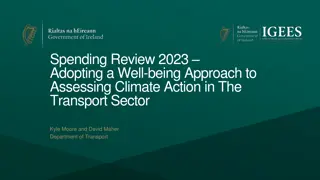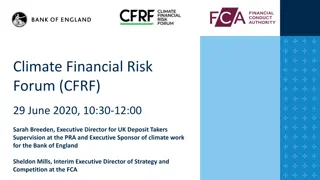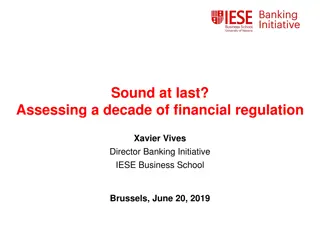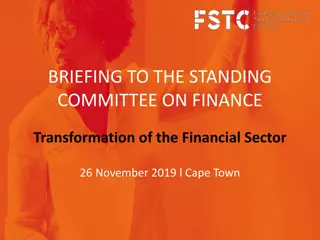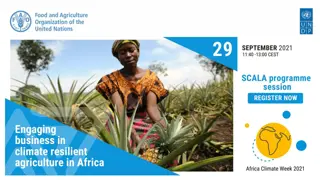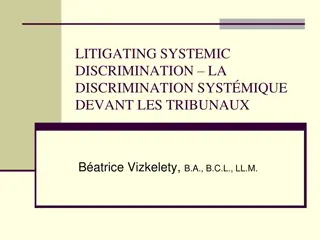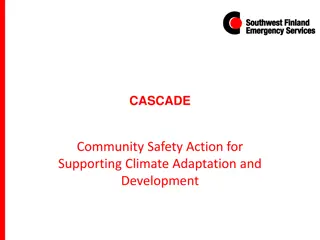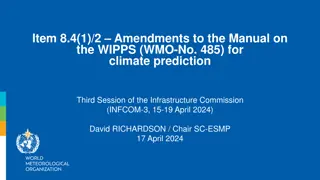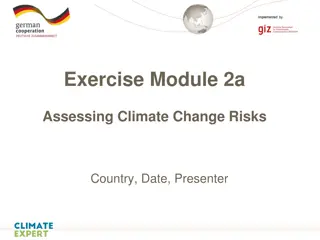Analyzing Systemic Climate Risk in the Financial Sector
This study discusses systemic climate risk in the financial sector by examining the effects of climate risks on financial institutions. It aims to design a market-based framework to assess the vulnerability of financial institutions to climate risks and analyze potential contagion effects. The framework includes measuring systemic risk, identifying climate risk factors, conducting test procedures, and proposing actions to mitigate systemic climate risk. The analysis focuses on the economic rationale behind re-pricing securities held by financial institutions due to climate shocks and the importance of understanding long-term scenarios and uncertainties in climate stress tests.
- Systemic Climate Risk
- Financial Sector
- Market-Based Framework
- Contagion Effects
- Climate Stress Tests
Download Presentation

Please find below an Image/Link to download the presentation.
The content on the website is provided AS IS for your information and personal use only. It may not be sold, licensed, or shared on other websites without obtaining consent from the author. Download presentation by click this link. If you encounter any issues during the download, it is possible that the publisher has removed the file from their server.
E N D
Presentation Transcript
SYSTEMIC CLIMATE RISK Tristan JOURDE (Banque de France) Quentin MOREAU (University of Glasgow) 2023 RiskLab/BoF/ESRB Conference Systemic Risk Analytics June 8-9, 2023
LAYOUT Introduction Objective Framework Literature review Data Results Robustness Conclusion Appendix Presenter: Tristan Jourde (Banque de France) Co-author: Quentin Moreau (University of Glasgow) 2
INTRODUCTION Source: https://www.bis.org/review/r151009a.pdf Presenter: Tristan Jourde (Banque de France) Co-author: Quentin Moreau (University of Glasgow) 3
INTRODUCTION Presenter: Tristan Jourde (Banque de France) Co-author: Quentin Moreau (University of Glasgow) 4
OBJECTIVE Design a market-based framework to examine the effects of climate risks on the financial sector: First-round effects: decrease in value of financial portfolios, credit worthiness of borrowers, etc. Second-round effects: climate shocks spread to other institutions through the financial network. => Broad definition of contagion : Exposure to common shocks, spillovers and pure contagion (Masson, 1998) Key questions: Which are the most vulnerable financial institutions (FIs)? Can climate risks generate contagion effects among FIs? Can FIs and policymakers undertake actions to mitigate systemic climate risk? Presenter: Tristan Jourde (Banque de France) Co-author: Quentin Moreau (University of Glasgow) 5
THE FRAMEWORK INTUITION The economic rationale : climate risks should lead to a repricing of securities (Carney, 2015) held by financial institutions. Purpose : assess whether climate shocks are reflected into asset prices and are already propagating to/among financial institutions. The framework complements the forward-looking approach of climate stress tests (e.g., Battiston et al., 2017; Vermeulen et al., 2018; ECB, 2022), based on long-term scenarios, but subject to uncertainty (Barnett et al., 2020). Presenter: Tristan Jourde (Banque de France) Co-author: Quentin Moreau (University of Glasgow) 6
THE FRAMEWORK SUMMARY A/ DESIGN INPUTS STEP 1 Systemic risk measure STEP 2 Climate risk factors B/ TEST FOR SYSTEMIC CLIMATE RISK STEP 3 Two-pass test procedure C/ ACTIONS TO MITIGATE SYSTEMIC CLIMATE RISK STEP 4 Determinants of FIs exposure to climate risks Presenter: Tristan Jourde (Banque de France) Co-author: Quentin Moreau (University of Glasgow) 7
THE FRAMEWORK STEP I Construct a market-based systemic risk measure: It captures 2 elements of systemic risk: (a) individual tail risks and (b) contagion effects. Dynamically estimate the Value-at-Risk (VaR) of each FIs and extract covariations (using a PCA analysis). Related indicators: Adams et al. (2014), Adrian and Brunnermeier (2016), and Kelly and Jiang (2014). Presenter: Tristan Jourde (Banque de France) Co-author: Quentin Moreau (University of Glasgow) 8
THE FRAMEWORK STEP II Build market-based climate risk factors for NFC: The factors capture the effect of climate shocks on the value of non-financial firms. We disentangle between (a) transition and (b) physical risks. Long-short factor mimicking portfolios (e.g., Fama & French, 1993) based on climate characteristics. At each point in time, we sort firms into brown and green portfolios and compute the difference of returns between the portfolios. Finally, we estimate the dynamic VaR of these factors (i) for consistency with the first step, (ii) to reflect extreme climate shocks, (iii) to account for uncertainty in the pricing of green and brown firms. 9
THE FRAMEWORK STEP II Factor reaction to endogeneous climate shocks: Presenter: Tristan Jourde (Banque de France) Co-author: Quentin Moreau (University of Glasgow) 10
THE FRAMEWORK STEP III Design a two-pass procedure to detect systemic climate risks Time-series regression of the variations in systemic risk on climate risk factors. Cross-sectional regression of financial institutions' contributions to systemic risk on financial institutions' exposures to climate risks. Presenter: Tristan Jourde (Banque de France) Co-author: Quentin Moreau (University of Glasgow) 11
THE FRAMEWORK STEP IV Determinants of FIs climate risk exposures: Financial characteristics. Environmental and governance features. Indirect carbon emissions (Scope 3), originating from the holding of securities and loans by financial institutions. Ownership structure (institutional / non-institutional) Climate disclosure and adaptation measures. 12
LITERATURE REVIEW (I) We contribute to 3 strands of literature: 1. The integration of climate risks into asset prices(e.g., Ardia et al., 2020; Bolton and Kacperczyk, 2021; Choi et al., 2020; Alok et al., 2020; Hong et al., 2019; Kruttli et al., 2021) We propose a flexible framework to assess whether extreme climate risks are reflected in the tail risk of equity markets. 2. The effect of climate risks on financial stability(e.g., Aevoae et al., 2022; Alessi et al., 2021; Anginer et al., 2018; Jung et al., 2021; Ojea-Ferreiro et al., 2022) Our framework focuses on tail risk dependence among FIs, allowing us to capture the potential second-round effects of climate risks. Presenter: Tristan Jourde (Banque de France) Co-author: Quentin Moreau (University of Glasgow) 13
LITERATURE REVIEW (II) We contribute to 3 strands of literature: 3. The link between (i) climate risks and (ii) environmental characteristics and disclosure(e.g., Dhaliwal et al., 2011; Ilhan et al., 2021; Li et al., 2020; Sautner et al., 2020) First to study the determinants of market-based measure of tail climate risks and adaptation measures. Presenter: Tristan Jourde (Banque de France) Co-author: Quentin Moreau (University of Glasgow) 14
DATA (I) Data goes from 2005 to 2022 for members of the European Union (+ UK, Switzerland and Norway). 371 active stocks of financial institutions (Banks, life insurers, non-life insurers, financial services, real estate - REIS and REITs). Thousands of active and dead non-financial European stocks to build climate risk factors. Presenter: Tristan Jourde (Banque de France) Co-author: Quentin Moreau (University of Glasgow) 15
DATA (II) For all companies, we retrieve: Financial data Datastream Refinitiv: prices including dividends, market capitalizations, book values of equity, cash holdings, total assets, incomes, net sales, and fixed assets Environmental data Datastream Refinitiv: Carbon emissions (Scope 1 & 2) Carbone 4: Carbon emissions induced by portfolio holdings (Scope 3) for financial institutions Trucost: Main physical risk scores ISS-ESG/Carbone4: Alternative physical risk scores Bloomberg/Datastream: Climate disclosure, ESG characteristics Institutional ownership data Securities Holdings Statistics (SHS-S) database: FIs holders by sector (Percentage of ownership by banks, insurance, and pension funds : items S_122, S_128, and S_129) Presenter: Tristan Jourde (Banque de France) Co-author: Quentin Moreau (University of Glasgow) 16
DATA (III) Control variables that can help explain variations in systemic risk: Systematic risk factors based on equity market data (Harvey et al, 2016) Hou-Xue-Zhang, Kenneth-French, Pastor-Stambaugh, AQR data libraries : size, value, momentum, expected growth, liquidity, quality-minus-junk, etc. => They capture different set of bad times (Ang, 2014), such as small and value firm distress (Fama and French, 2015); momentum crashes (Daniel and Moskowitz, 2016) Other macroeconomic and financial factors (Lettau et al., 2008; Adrian et al, 2016) Bloomberg, ECB, Eurostat, Fred: default premium, interbank market liquidity, yield curve spread, economic sentiment, etc. 17
RESULTS INDIVIDUAL EXPOSURES TO CLIMATE RISKS Climate Exposure CoVaR measure that incorporates extreme climate risks as potential stress factors for financial institutions. Run individual time-series regressions ? VaR?,?= ? + ????????+ ????????+ ?????,?+ ?? ?=1 Market risk factors Dynamic VaR of FIs Transition risk factor Physical risk factor Aggregate results using the mean-group estimator (Pesaran, 1995) Transition risk (????) Physical risk (????) Presenter: Tristan Jourde (Banque de France) Co-author: Quentin Moreau (University of Glasgow) 18
RESULTS TRANSITION RISK BY FINANCIAL INDUSTRY Presenter: Tristan Jourde (Banque de France) Co-author: Quentin Moreau (University of Glasgow) 19
RESULTS EFFECT OF CLIMATE RISKS ON SYSTEMIC RISK (I) The two-pass test procedure: 1. Time series regression : are climate risks associated with tail risk dependence among FIs? ? 1,?= ? + ????????+ ????????+ ?????,?+ ?? ?=1 Covariations in tail risk among FIs (1stPC) 2. Cross-sectional regression : Do FIs most exposed to climate risks contribute more to global risk? ? 1,?= ? + ???? ????,?+ ???? ????,?+ ??? ???,?+ ?? ?=1 Contribution of each FIs to tail risk dependence (weights on the 1stPC) Presenter: Tristan Jourde (Banque de France) Co-author: Quentin Moreau (University of Glasgow) 20
RESULTS EFFECT OF CLIMATE RISKS ON SYSTEMIC RISK (II) Transition risk affects systemic risk, while physical risk does not. The magnitude of the effect of transition risk is moderate. Results are robust to alternative sets of systematic and market stress factors. In the time series In the cross-section (1) 1 1.392** (0.545) (2) 1 0.898* (0.486) (5) 1 (6) 1 VARIABLES VARIABLES ???? 0.010*** (0.002) 0.011*** (0.003) BMG ???? -0.001 (0.002) -0.001 (0.002) VMS -0.063 (1.755) -1.237 (1.850) ???? 0.010 (0.012) 0.008 (0.015) MKT 3.272*** (0.373) 3.178*** (0.423) ???? 0.003*** (0.001) 0.003*** (0.002) SMB 11.396*** (3.356) 11.202*** (3.253) ???? 0.002 (0.002) 0.004 (0.005) HML 6.118*** (1.603) 6.014*** (1.822) ???? 0.001 (0.004) RMW -0.988 (3.388) ???? 0.004 (0.011) CMA 0.325 (0.552) ???? 0.016 (0.010) WML 0.623*** (0.231) Observations R-squared Adjusted R-squared FE : Country FE : Industry 371 0.309 0.239 Yes Yes 371 0.321 0.245 Yes Yes Constant -0.057 (0.305) -0.062 (0.296) Observations R-squared Adjusted R-squared 207 0.820 0.816 207 0.829 0.822 Presenter: Tristan Jourde (Banque de France) Co-author: Quentin Moreau (University of Glasgow) 21
RESULTS CHARACTERISTICS CORRELATED WITH TRANSITION RISK FIs with high transition risk exposure have higher market capitalizations (ECB, 2022). FIs with lower Scope3 emissions, reliable emission data/emission reduction pathways, and with long-term orientation are less exposed to transition risk. (1) (2) (3) VARIABLES ? ?????? ? ?????? ? ?????? Beta (t-1) 0.0439*** 0.0234** -0.00373 (0.0113) (0.0112) (0.0716) LogMarketValue (t-1) 0.0236*** 0.0254*** 0.0746*** (0.00265) (0.00274) (0.0161) Cash (t-1) -0.259*** -0.229*** -0.194 (0.0566) (0.0629) (0.238) NetIncome (t-1) 0.252*** 0.155* -0.178 (0.0885) (0.0884) (0.249) MtoB (t-1) 0.00620 0.00268 -0.0432** (0.00449) (0.00443) (0.0203) (0.0930) LowScope3intensity (t-1) (0.0639) VerifiedScope3 (t-1) ReductionTargetReached (t-1) Board LT incentives (t-1) Institutionalownership(t-1) Constant -0.108*** -0.251*** -0.248 (0.0170) (0.0784) (0.201) Observations 5,992 5,992 3,245 R-squared 0.036 0.161 0.134 Adjusted R-squared 0.036 0.157 0.122 Country Fixed Effects No Yes Yes Industry Fixed Effects No Yes Yes Institution Fixed Effects No No No Year Fixed Effects No No Yes (4) ? ???? -0.300 (0.205) 0.200 (0.175) 0.528 (0.762) -0.928 (0.590) -0.0266 (5) ? ???? -0.431* (0.226) -0.0532 (0.185) 0.0251 (1.095) -1.523 (0.943) 0.378** (0.152) -0.297* (0.153) (6) ? ???? -0.439** (0.189) 0.0269 (0.211) -0.409 (0.774) -0.471 (0.829) 0.251 (0.172) (7) ? ???? -0.0931 (0.0973) 0.0312 (0.0748) -0.184 (0.334) -0.239 (0.261) -0.0331 (0.0386) (8) ? ???? -0.0921 (0.0846) -0.0201 (0.0645) 0.125 (0.343) 0.110 (0.223) -0.0576 (0.0500) -0.118* -0.137** (0.0678) 0.669 (1.695) 699 0.716 0.645 Yes Yes -0.0723* (0.0412) 0.235 (0.478) 3,245 0.541 0.481 Yes Yes -0.363*** (0.114) 0.660 (0.418) 2,222 0.706 0.649 Yes Yes -0.693 (1.421) 925 0.652 0.570 Yes Yes -0.693 (1.421) 715 0.631 0.575 Yes Yes Presenter: Tristan Jourde (Banque de France) Co-author: Quentin Moreau (University of Glasgow) 22
RESULTS CHARACTERISTICS CORRELATED WITH PHYSICAL RISK FIs with high physical risk levels have lower market capitalizations. VARIABLES Beta (t-1) LogMarketValue (t-1) Cash (t-1) NetIncome (t-1) MtoB (t-1) Board LT incentives (t-1) Institutional ownership (t-1) Constant Observations R-squared Adjusted R-squared Country Fixed Effects Industry Fixed Effects Institution Fixed Effects Year Fixed Effects (1) (2) (3) ? ???? 0.433* (0.224) -0.0527 (0.0424) -0.0367 (0.588) 0.211 (0.768) -0.0160 (0.0787) (4) ? ???? 0.0898 (0.319) -0.434** (0.186) 0.0485 (0.519) 0.396 (0.675) 0.113 (0.0964) -0.0175 (0.159) (5) ? ???? -0.387 (0.293) -0.434* (0.224) 0.688 (0.545) -0.285 (0.824) 0.243** (0.102) -0.0908 (0.324) 2.996* (1.533) 2,222 0.644 0.575 Yes Yes ? ?????? 0.299*** (0.0538) -0.0934*** (0.0106) -0.334* (0.201) 0.265 (0.319) -0.0513*** (0.0189) ? ?????? 0.327*** (0.0496) -0.0544*** (0.0109) 0.521** (0.226) 0.439 (0.323) -0.0310* (0.0178) 0.310*** (0.0627) 5,992 0.020 0.019 No No No No 1.665*** (0.226) 5,992 0.217 0.213 Yes Yes No No 0.595 (0.618) 3,245 0.139 0.127 Yes Yes No Yes 2.917** (1.280) 3,245 0.504 0.439 Yes Yes Presenter: Tristan Jourde (Banque de France) Co-author: Quentin Moreau (University of Glasgow) 23
RESULTS ADAPTATION MEASURES TO TRANSITION RISK FIs with higher exposure to transition risk engage in selective ESG/climate disclosure (e.g., Management Discussion and Analysis section of annual reports, allowing communication in a flexible manner (Brown et al., 2021). Potential suspicion of greenwashing (Campbell et al., 2014; Yu et al., 2020). Column (5) : Evidence against regulatory capture concerns (see also Schneider et al., 2023). (1) (2) (3) (4) Log (5) Policy Engagement -0.397** (0.201) -1.397 (1.114) Integrated Strategy 0.246*** (0.0940) -2.297*** (0.673) Discuss ClimateRisk 0.323*** (0.111) -1.067 (0.688) Environmental Disclosure Score -0.0261** (0.0127) 0.183* (0.103) VARIABLES CarbonOffsets 0.413* (0.245) -4.796 (3.836) ? ??? (t-1) Constant Observations R-squared Adjusted R-squared Controls Country-Year Fixed Effects Industry-Year Fixed Effects 1,136 Yes Yes Yes 1,292 Yes Yes Yes 978 0.709 0.635 Yes Yes Yes 335 0.618 0.339 Yes Yes Yes 812 Yes Yes Yes Presenter: Tristan Jourde (Banque de France) Co-author: Quentin Moreau (University of Glasgow) 24
RESULTS ADAPTATION MEASURES TO PHYSICAL RISK As most investors expect physical risk to become material within a few years (Krueger et al., 2020), financial institutions might already take action to face it. FIs with higher exposure to physical risk engage in various initiatives to reduce their environmental footprints. VARIABLES (1) (2) (3) (4) (5) ResourceScore Environmental Team Environmental Products Climate Scenario Analysis Supplier Climate Engagement ? ??? (t-1) Constant 1.131* (0.615) 0.123*** (0.0427) 0.0979*** (0.0349) 0.0958* (0.0502) 0.533*** (0.174) -70.37*** (10.55) -3.704*** (0.660) -5.524*** (0.748) -4.075*** (0.800) -6.687*** (2.005) Observations R-squared Adjusted R-squared Controls Country-Year Fixed Effects Industry-Year Fixed Effects 1,273 0.566 0.482 Yes Yes Yes 1,256 Yes Yes Yes 1,341 Yes Yes Yes 757 Yes Yes Yes 353 Yes Yes Yes Presenter: Tristan Jourde (Banque de France) Co-author: Quentin Moreau (University of Glasgow) 25
ROBUSTNESS TESTS Use alternative climate risk factors (L/S portfolios based on different characteristics). Transition risk factors: 90% correlation based on Scope 1 (reported) only vs. Scopes 1 + 2 (estimated & reported) Physical risk factors: Only 26% correlation on average between the factors based on Trucost, ISS-ESG and Carbone4 Large disagreement between physical scores that can lead to dispersion in investment flows, limiting or delaying the incorporation of physical risks into asset prices (see Billio et al., 2021 for ESG scores). The results remain non-significant based on each physical risk score. Presenter: Tristan Jourde (Banque de France) Co-author: Quentin Moreau (University of Glasgow) 26
CONCLUSION We build a market-based framework to: identify the FIs most exposed to tail climate risks detect potential contagion effects arising from climate risks We find that transition risk affects systemic risk, while physical risk does not. FIs that are less exposed to transition risks have: lower Scope3 emissions, reliable emission data/emission reduction pathways long-term orientation Our framework is flexible : It can be used to dynamically monitor whether the effect of climate risks on financial stability is becoming a growing concern from an investor perspective It can be used on other countries, sectors, asset types and periods. It can be used to assess other types of emerging risk for financial stability. Presenter: Tristan Jourde (Banque de France) Co-author: Quentin Moreau (University of Glasgow) 27
Thank you for your attention ! Any feedback is highly welcome The paper is available on SSRN : Email: tristan.jourde@banque-france.fr quentin.moreau@glasgow.ac.uk
APPENDIX DYNAMIC VaR ESTIMATION The VaR is the estimated loss of a financial institution that, within a given period, will not be exceeded with a certain probability ?: ???? ???????< ????| ? = ? The VaR can be estimated dynamically: ????,?= ??,?+ ??,?|? 1?(1 ?) 1 where ??,?|? 1is the conditional standard deviation given the information at ? 1, ? 1is the inverse probability density function of a pre-specified distribution and ??,?is the mean returns of institution i at time t. Following Kuester et al. (2006), we model ??,?by extracting the conditional standard deviation from a GARCH model. We apply the threshold GARCH model of Glosten et al. (1993): 2= ? + ? + ??? 1?? 1 ?? 1= 0, 2 2 ??,? + ? ??,? 1 ?? 1< ? ?? 1 ? 1, All the parameters (?, ?, ?, ?, and ?) are estimated simultaneously, by maximizing the log-likelihood. Presenter: Tristan Jourde (Banque de France) Co-author: Quentin Moreau (University of Glasgow) 29
APPENDIX TIME VARIATION IN SYSTEMIC RISK The indicator represents the first principal component 1accounting for the common variations in the VaR of FIs. The chart on the left is in levels (January 2005 = 100), while the chart on the right is in first difference. Presenter: Tristan Jourde (Banque de France) Co-author: Quentin Moreau (University of Glasgow) 30
APPENDIX CLIMATE RISK FACTORS We build factor-mimicking portfolios (Fama and French, 1993) based on climate characteristics: Transition risk: Carbon emission intensity (Scope 1 & 2 divided by net sales) Physical risk: Trucost physical climate risk scores based on seven hazards (coldwave, flood, heatwave, hurricane, sea-level rise, water stress, wildfire) using a 2050-horizon moderate-intensity climate change scenario. At each period, we sort non-financial firms into 5 portfolios based on quintile of climate characteristics. To mitigate correlation with existing factors, the transition risk factor is constructed using six value- weighted portfolios formed on market capitalization, book-to-market, and the two lowest and highest deciles of carbon emissions ????=???+ ???+ ???+ ??? ???+ ???+ ???+ ??? 4 4 As correlation with HML is naturally low, the physical climate factor is built using four value-weighted portfolios formed on size and the two lowest and highest deciles of Trucost physical scores ????=???+ ??? ???+ ??? 2 2 Since we are interested in extreme climate risk, we estimate the VaR of each climate risk factor. Presenter: Tristan Jourde (Banque de France) Co-author: Quentin Moreau (University of Glasgow) 31
APPENDIX FACTOR CORRELATION BMG VMS MKT SMB HML RMW CMA WML RR ML DP YC NS VMS -5% MKT 0% 25% SMB 10% 15% 25% HML -22% 13% 37% 33% RMW -1% 10% 31% 15% 47% CMA 19% 17% 32% 23% -2% 15% WML 21% 26% 26% 15% 21% 22% 17% RR 4% 0% -2% -1% -14% -11% 11% -11% ML -5% 12% 29% 27% 11% 33% 13% 12% -13% DP -3% 26% 80% 41% 41% 38% 29% 32% -1% 39% YC -4% 1% 3% -4% 4% 2% 1% 5% 5% 12% 8% NS -6% 9% 16% -2% 17% -4% 1% 8% 6% 3% 7% 27% ES -7% 13% 47% 46% 63% 12% 12% 19% 4% 7% 47% 1% 17% Presenter: Tristan Jourde (Banque de France) Co-author: Quentin Moreau (University of Glasgow) 32
APPENDIX PHYSICAL RISK BY FINANCIAL INDUSTRY Presenter: Tristan Jourde (Banque de France) Co-author: Quentin Moreau (University of Glasgow) 33
APPENDIX TRANSITION RISK BY COUNTRY Presenter: Tristan Jourde (Banque de France) Co-author: Quentin Moreau (University of Glasgow) 34
APPENDIX PHYSICAL RISK BY COUNTRY Presenter: Tristan Jourde (Banque de France) Co-author: Quentin Moreau (University of Glasgow) 35
APPENDIX OTHER FACTORS DESCRIPTION (I) Variable Description Difference between the returns on portfolios of low and high investment stocks (Conservative-Minus-Aggressive factor), based on the change in total assets divided by total assets from Kenneth French website library. CMA Default premium computed as the spread between the ICE high yield euro corporate rates against the 3-month Euribor rate (Fred database). DP Difference between the returns of portfolios of high and low expected growth stocks (Expected Growth factor) from Hou-Xue-Zhang q-factors data library. EG Economic Sentiment indicator (Eurostat). ES Difference between the returns on portfolios of high and low book-to-market stocks (High-Minus-Low factor) from Kenneth French website library. HML Difference between the returns on portfolios of high and low investment-to-assets stocks (Investment/Assets factor) from Hou-Xue-Zhang q-factors data library. IA LIQ Non-traded liquidity factor of Pastor and Stambaugh (2003) from https://faculty.chicagobooth.edu/lubos-pastor/data ME Difference between the returns on portfolios of small and large stocks from Hou-Xue-Zhang q-factors data library. MKT Difference between the returns on the market portfolio and the risk-free rate (Market factor) from Kenneth French website library. Presenter: Tristan Jourde (Banque de France) Co-author: Quentin Moreau (University of Glasgow) 36
APPENDIX OTHER FACTORS DESCRIPTION (II) Variable Description ML Interbank Market Liquidity indicator, calculated as the spread between the 3-month Euribor rate against the equivalent Overnight Indexed Swap rate. NS North-South spread, computed as the difference between the 10-year German sovereign bond rate against an average of Greece, Ireland, Italy, Spain, and Portugal 10-year rates (European Central Bank). QMJ Quality-Minus-Junk (QMJ) factor that invests long quality stocks and shorts junk stocks (Asness et al., 2014) from the AQR library. RMW Difference between the returns of robust and weak stocks (Robust-Minus-Weak factor), based on operational profitability (revenues divided by book equity) from Kenneth French website library. ROE Difference between the returns on portfolios of high and low profitability stocks (Return on Equity factor), based on the income before extraordinary items divided by one-quarter-lagged book equity; from Hou-Xue-Zhang q-factors data library. RR Risk Reversal on the USD/EUR options from Bloomberg. SMB Difference between the returns on portfolios of small and large stocks (Small-Minus-Big factor) from Kenneth French website library. WML Difference between the returns on portfolios of past winner and past loser stocks (Momentum factor) from Kenneth French website library. YC Yield Curve indicator, computed as the spread between 10-year and 2-year Euro Area composite rates (European Central Bank). Presenter: Tristan Jourde (Banque de France) Co-author: Quentin Moreau (University of Glasgow) 37
APPENDIX OTHER VARIABLE DESCRIPTION (II) Variable Description Beta Equity beta (897E in Datastream). Board LT incentives Dummy variable equal to one if board members have long-term compensation incentives (from CGCPDP052 in Refinitiv ESG). Cash Ratio of cash (item WC02005 in Worldscope Datastream) to total assets (item WC02999 in Worldscope Datastream). ClimateScenarioAnalysis Dummy variable equal to one if the financial institution has conducted a climate scenario analysis for its portfolio of financial assets (CLIMATE_SCENARIO_ANALYSIS in Bloomberg). DiscussClimateRisk Dummy variable equal to one if the Management Discussion and Analysis (MD&A) or its equivalent risk section of the financial institution's annual report discusses business risks related to climate change (CLIMATE_RISKS in Bloomberg). Environmental Dislosure Score Score (ENVIRONMENTAL_PILLAR_DISCLOSURE in Bloomberg). based on the extent of a company's Environmental disclosure EnvironmentalProducts Dummy variable equal to one if the financial institution has at least one product line or service that is designed to have positive effects on the environment (item ENPIDP019 in Datastream). EnvironmentalTeam Dummy variable equal to one if the financial institution has an environmental management team (item ENRRDP004 in Datastream). ESG Disclosure Score Score based on the extent of a company's Environmental, Social, and Governance (ESG) disclosure (ESG_DISCLOSURE_SCORE in Bloomberg). Presenter: Tristan Jourde (Banque de France) Co-author: Quentin Moreau (University of Glasgow) 38
APPENDIX OTHER VARIABLE DESCRIPTION (II) Variable Description Institutional ownership Percentage of ownership by banks, insurance, and pension funds (sum of items S_122, S_128, and S_129 from the Securities Holdings Statistics database) IntegratedStrategy Dummy variable equal to one if the financial institution integrates extra-financial factors in its management discussion and analysis (MD&A) section in the annual report. LogCarbonOffsets Natural logarithm of the equivalent of the CO2 offsets, credits, and allowances purchased and/or produced by the financial institution during the year. LogMarketValue Natural logarithm of market capitalization (item MV in Datastream, expressed in million euros). LowScope3intensity Dummy variable equal to one if the financial institution s Scope3 emissions to revenues (in million USD) ratio is in the bottom quartile (from item in Datastream). MtoB Ratio of market value of equity (item MV in Datastream, expressed in million euros) to book value of equity (item WC03501 in Worldscope Datastream, expressed in thousand euros), multiplied by 1,000. NetIncome Ratio of net income (item WC01751 in Worldscope Datastream) to total assets (item WC02999). PolicyEngagement Dummy variable equal to one if the financial institution engages with policymakers on possible responses to climate change (from CDP). ReductionTargetReached Dummy variable equal to one if the financial institution has reached or completed an emissions reduction target during the year (from CDP). ResourceScore Resource score, reflecting the financial institution s performance and capacity to reduce the use of materials, energy, or water, and to find more eco-efficient solutions (item TRESGENRRS in Datastream). SupplierClimateEngagement Dummy variable equal to one if the financial institution engages with its suppliers on climate change issues (from CDP). VerifiedScope3 Dummy variable equal to one if all of the financial institution s Scope 3 emissions have been verified by a third party (from CDP). Presenter: Tristan Jourde (Banque de France) Co-author: Quentin Moreau (University of Glasgow) 39









